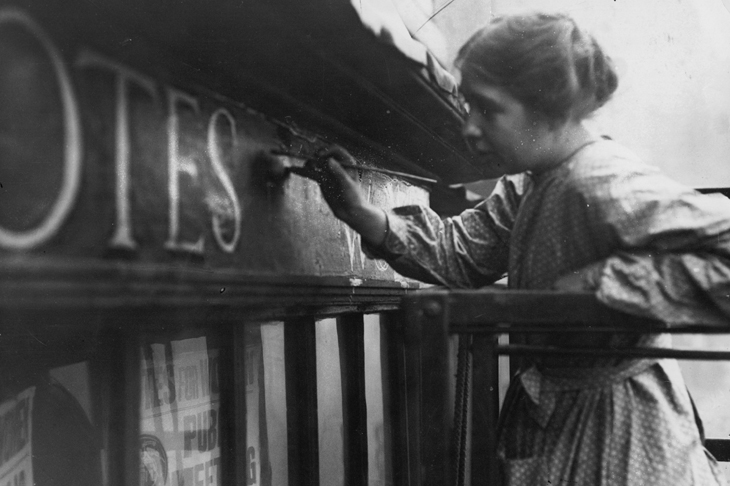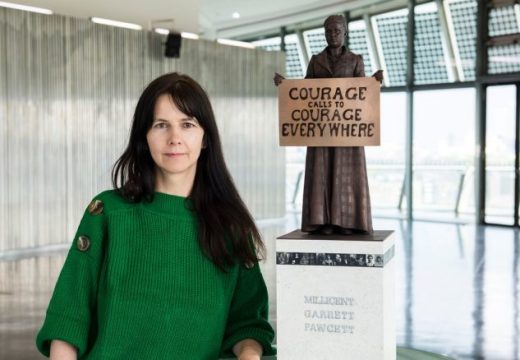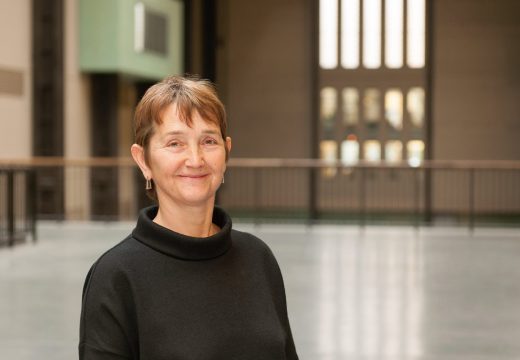Sylvia Pankhurst (1882–1960) was a great political campaigner, in many ways ahead of her times; a visionary but not an ideologue, she worked to facilitate change on the ground in terms moulded by those affected. Unlike her mother Emmeline, and sister, Christabel, she had an intersectional approach to winning the vote that embraced the plight of the working class and worked to empower women from all backgrounds. She was also, in her early adulthood, an ambitious artist – and while she later officially ‘gave up art’ in order to devote her energy to campaigning for the Women’s Political and Social Union (WSPU; founded by her mother in 1903), her creative output continued, channelled in a new direction. (Bringing national attention to the significant contribution that Sylvia Pankhurst has made to British art history was the motivation behind the ‘Sylvia Pankhurst’ display at Tate Britain in 2013–14, instigated by The Emily Davison Lodge, a conceptual institution founded by myself and Olivia Plender.)
‘Art was my chosen mission […] which gave me satisfaction and pleasure found in nothing else’, Pankhurst later recalled of her decision to train as an artist. From an early age she had admired the work of William Morris and Walter Crane and hoped to one day ‘decorate halls where people would foregather in the movement to win the new world’. Initially attending the Manchester School of Art (1900–02), where she won the award for best female student, she went on to gain a two-year scholarship to study at the Royal College of Art (1904–06) – with the distinction of having achieved the highest grades of any candidate. Apart from a series of studies made in Venice, it seems that no works survive from this period. Fortunately, a large series of gouaches, watercolours and charcoal works from her ‘Women Workers of England’ tour in 1907 still exists. Pankhurst took it upon herself to travel the country visually recording the working conditions of women in various industries, going from the Staffordshire potteries to the Glasgow cotton mills. Working on site in often extreme conditions, the images she produced are remarkable for both their beauty and radical critical intention.

In a Glasgow Cotton Mill: Minding a Pair of Fine Frames (1907), Sylvia Pankhurst. Installation view at Tate Britain, London, 2013–14. Photo: Matthew Booth
Pankhurst publicised her tour’s findings, of poor working conditions and unequal wages, by writing an article and reproducing her images in the London Magazine in 1908. She never did complete her studies at the RCA, in part because she was not awarded a final-year scholarship – but also due to her belief that a successful artistic career would be in service of the pleasures of the wealthy elite and her own self-centred ambition, as opposed to society and its problems. She questioned her conscience: ‘Are we brothers of the brush entitled to the luxury of release from utilitarian production? Is it just that we should be permitted to devote out entire lives to the creation of beauty, while others are meshed in monotonous drudgery?’ And so, at the age of 27, Pankhurst turned her full attention to the suffragette cause, helping to establish the first branch of the WSPU in London.

White porcelain teapot set (1909), designed by Sylvia Pankhurst and produced by the Women’s Social and Political Union; currently on view in the display ‘People’s City: Suffragettes’ at the Museum of London. Courtesy Museum of London
Alongside her political campaigning, Sylvia Pankhurst designed banners, badges, membership cards, many of which incorporated what was to become the main visual motif of the WSPU: the angel of freedom. The winged female figure sounding a trumpet appeared everywhere from a special edition tea service, produced and sold to raise funds for the union, to the cover of its first edition of the Votes for Women newspaper. Gone was the representational realism that Pankhurst had practiced at art school and which predominated in the galleries at the time, and in came a fusion of fine art, craft and propaganda for use in processions and protests.
Also produced during this time were objects only available within the union, designed not to promote but to cohere the movement. The ‘Holloway brooch’, the suffragette equivalent of a medal of honour, was awarded to suffragettes who had undergone hunger strike in prison. The Portcullis symbol of Parliament is rendered in silver, overlaid with a broad arrow enamelled in the suffragette colours of purple, white and green. Here we see Pankhurst’s creative skill used to celebrate and inspire, art and politics merged together. Similarly impressive are the enormous wall hangings (totalling around 45 metres wide and 75 metres long) that Pankhurst painted for the Women’s Exhibition, a fundraising event publicising the suffragette cause, at the Princes Skating Rink in 1909. Framed in a series of ornate arches of purple, white and green plant forms, female figures are depicted with various symbols to form allegories of adversity, courage and hope. The central figure is shown sowing seeds as she looks nervously forward, while above her head three doves hover bearing an olive branch.

The Holloway brooch (1909; produced in 1912), designed by Sylvia Pankhurst. Courtesy Museum of London
Sylvia Pankhurst’s strong socialist beliefs and actions, which did not align with the vision of WSPU leaders including her mother and sister, led to her expulsion from the union in early 1914. In response, she formed the independent East London Federation of the Suffragettes. Alongside continued campaigning for suffrage, she initiated a co-operative toy factory and associated creche where women could earn a living; a volunteer-run mother and baby clinic; a people’s army to protect protesters; and a cheap restaurant at a former pub, renamed the Mother’s Arms. Today, these initiatives and the community of concern established through her expanded approach to both social justice and art might win Pankhurst the Turner Prize.

Sylvia Pankhurst’s mural hangings at the Women’s Exhibition & Sale of Colours, Prince’s Skating Rink, Knightsbridge, May 1909. Photo: Christina Broom. Courtesy Museum of London
As Emmeline Pethick-Lawrence, one of the leaders and main funders of the WSPU, once observed, Pankhurst’s, ‘passion for beauty, great as it was, had to yield in the end to her passion of imaginative pity’. Yet, her reflections in The Suffragette Movement: An Intimate Account of Persons and Ideals, published in 1931, include multiple statements about how dear art was to her and how a world without it was indeed a world of drudgery. And the photograph in the book’s first-edition frontispiece is not one of those where Pankhurst is addressing crowds of people, but a portrait of the artist painting the murals for the Women’s Exhibition of 1909.
This year the UK is commemorating 100 years since the Representation of the Peoples Act 1918, which allowed (some) women to vote for the first time in history. Today is also International Women’s Day, an event that celebrates the achievements of women and advocates for gender equality.
Unlimited access from just $16 every 3 months
Subscribe to get unlimited and exclusive access to the top art stories, interviews and exhibition reviews.














![Masterpiece [Re]discovery 2022. Photo: Ben Fisher Photography, courtesy of Masterpiece London](http://www.apollo-magazine.com/wp-content/uploads/2022/07/MPL2022_4263.jpg)
It’s time for the government of London to return to its rightful home